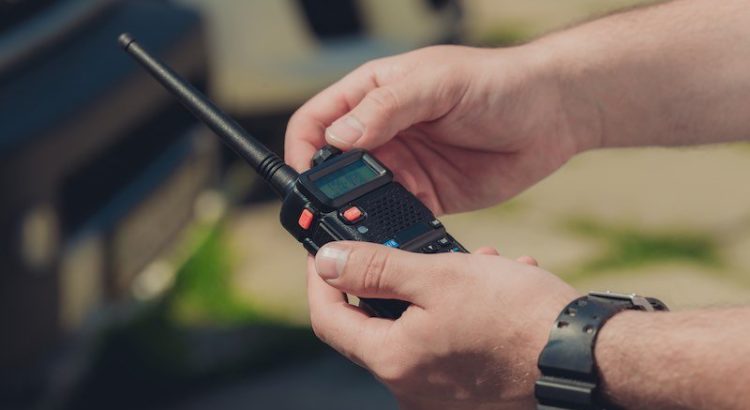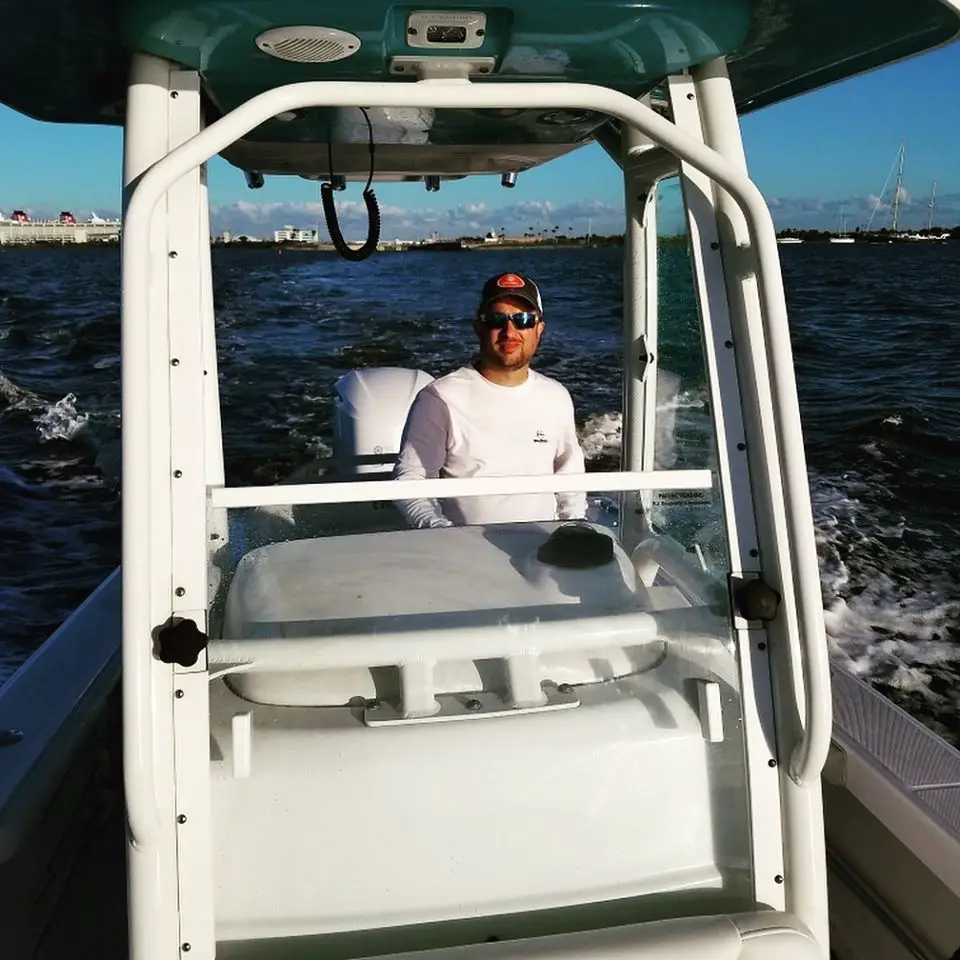This page contains affiliate links. This means that we may get a small commission for recommending products, if you choose to click on something and buy it. This does not cost you anything, but we wanted to be honest and let you know!
(Last Updated On: )Whether you are an avid or every so often boater, your priority should be safety, both your own and the safety of those who might accompany you on the foamy waves. We have compiled for you a list of the best floating VHF radio in 2021 and a very comprehensive guide to VHF radios and marine communication.
| VHF Radio | Preview | Weight |
| Standard Horizon HX210 | 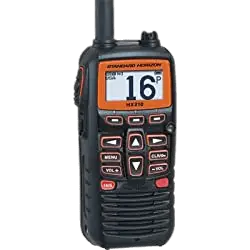 |
1.65 lbs |
| Cobra COB-MR HH600W | 0.72 lbs | |
| Radioddity Voyage RV6 VHF | 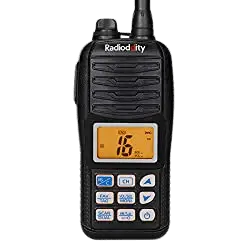 |
0.54 lbs |
| Retevis RT55 | 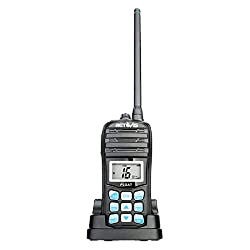 |
0.63 lbs |
| Standard Horizon HX890 | 2.21 lbs |
Table of Contents
Best Floating VHF Radios Review
#1. Standard Horizon HX210
The Standard Horizon has a compact, ergonomic case design and a large capacity 1850 mAh Lithium-Ion battery. This gives the radio a much smaller case design, yet keeps it light enough to float face up if dropped in the water.
Even if the unit is turned off, an emergency strobe will be activated if the radio falls in the water.
The strobe can be reconfigured to flash on and off, flash SOS, or set to stay on continuously.
If your Standard Horizon HX210 ever fails for any reason including water damage during normal use in the first three years, Standard Horizon will repair or replace it free.
- Compact Case Design. Water Activated Emergency Strobe light. Oversized full dot matrix display. E20 Easy to Operate Menu System
- 3-year Waterproof Warranty. Floating / Submersible IPX7 Waterproof rating (3.3 feet or 1 meter for 30 minutes). Built-in F.M. Broadcast band receive
- All USA, International, and Canadian channels. Selectable 6W / 2.5W / 1W output power. Receive W.X. and F.M. radio bands 76MHz to 108MHz
- High-resolution dot-matrix LCD. Programmable function keys. Speaker mic Jack.
- High capacity 1850 mAh Li-Ion battery. 3-hour desktop rapid charger. 12VDC and 110VAC charging cables and charging cradle included.
#2. Cobra COB-MR HH600W FLT GPS BT MRHH600
With the Cobra, you will have instant access to channel 16 and channel 9 for emergencies. You can scan channels programmed in memory to find conversations in progress. The Cobra gives you access to national hazards and weather information, 24 hours a day.
It produces 1, 3, or 6 watts of output power for near or distant calling. Designed to IPX8 (JIS8) standards for water submersion. The Cobra will alert you to weather emergencies with a tone on a weather channel you can select for your area.
- Made in the USA
- Built-in GPS receiver & DSC
- All NOAA weather channels
- Bluetooth wireless technology
#3. Radioddity Voyage RV6 Floating VHF Radio
If you are looking for a radio that is simple to set up and use, the Radioddity is just that VHF. Because of its compact size, it is perfect for use in a kayak, rowboat, or paddleboarding.
Another great feature is the dual-channel and tri-channel watch. This allows you to monitor a designated channel while also keeping a watch on Channel 16, or you can have it one Channel 16 and another channel, such as Channel 9.
The radio scans through the two or three channels, so you don’t miss any important calls.
- Tri-watch mode monitors three channels (Channel 16, Channel 9, and the current channel) at once. Easy to access the emergency channel 16 and call the coast guard for help via the 16/C button.
- The radio floats and sends out a red flashing light on the bottom if dropped in water, making it easier to be located and retrieved even in the dark. It’s submersible for up to 30 minutes in water up to 3ft/1m.
- No worry if water gets into the speaker grill and muffles the audio, RV6 can emit a vibrating sound and shed water away.
- Easy to pick up the 10 NOAA weather channel, it will be a lifesaver in case the sudden change in the weather while on the boat.
- It covers all USA, International, and Canadian marine channels, keeping you with most up-to-date marine activities.
#4. Retevis RT55
If the Retevis marine radio accidentally falls into the water, it can float and is resistant to saltwater corrosion. The large LCD screen makes for an easy to read display.
An oversized keyboard ensures that you can easily operate and use the radio even when wearing gloves. NOAA Weather Scan and Alert will automatically scan ten weather channels to provide you with the latest weather updates and alert you to severe weather.
- The wide frequency range covers all the USA and Canada and International marine channels; High power can also give you a large signal range
- Tri-watch function allows you to monitor the current channel and the emergency channel 16; TAG hot button enables you to collect the channels you want quickly
- NOAA weather alarm will automatically scan to alert you of severe weather updates and a signal indicating a risk of severe weather;
- The LCD screen is backlit, and the screen clarity can be adjusted from low to high to adapt to bad weather
- Rugged and durable meets the military standard
#5. Standard Horizon HX890
The Standard Horizon received a 4.7-star rating out of 5 stars on Amazon. It is a new model from Standard Horizon, with a few new features. It has a two scrambler system built-in and a built-in F.M. broadcast band receiver.
There is a switchable day or night time mode, waypoint, and route navigation. The case has a new, ergonomic design. One of the reviewers stated that this model was a bit complicated to use, but worth the time to learn how to operate.
- HX890 comes packaged with all the accessories including the rechargeable Li-Ion battery, Alkaline battery tray, 110V wall charger, 220V adapter, charging cradle, 12V charger, P.C. programming cable and belt clip with lanyard
- 6W transmit power output (Selectable 6/ 2/ 1 W) | 700mW Loud Audio and Noise-Canceling Function for both TX/RX audio | Submersible IPX8 Construction, and it floats
- DSC (Digital Selective Calling) ITU-R M.493 Class-H Operation | W2.60’’ x H5.43’’ x D1.50’’ – Round Case Design provides excellent ergonomics
- Built-in Integrated 66 channel WAAS GPS Receiver | 11-hour Operating Time with 1800mAh high capacity Li-ion battery | Easy to Operate Menu System with a large (1.7” x 1.7”) Full-dot matrix display | Selectable Display Mode – Day & Night Mode | Waypoint and Route navigation | Group Monitor Function utilizing DSC Group Position Call
- MOB (Man over Board) feature | Water Activated Emergency “WHITE” Strobe Light | Two Scrambler Systems built-in – 4-code CVS2500A & 32-code FVP-42
How Important Is Marine Communication?
Besides the obvious life jacket, you should also have a lifeline. An instrument that can call for help and bring assistance that might mean the difference between life and death.
That valuable piece of equipment is a VHF radio. The radio will be your go-to communication in an emergency.
The U.S. Coast Guard has a vast network of towers to listen in on distress calls. Not only the Coast Guard, but every other nearby boater with a radio can hear you, which greatly increases your chances for survival in an emergency.
Before you venture out on the water, it is important to know something about marine communication. Three emergency signals are recognized internationally for voice communication.
What VHF Radio Signals to Use?
These are the signals that you will use to call on your VHF radio (heaven forbid) you are in distress on the water.
- Mayday: This is a distress signal. It is used ONLY when a vessel is threatened by grave and imminent danger and requires immediate assistance.
- Pan-Pan: This is an urgency signal and is used when a vessel or person’s safety is at risk.
- Securite: (pronounced SAY-CURE-A-TAY) This is a safety signal. It is used to advise others about any important navigation or weather that might impact the safety of other vessels.
If you hear a distress call, you should immediately cease all of your transmissions. No one is allowed to transmit until it is evident that assistance has been provided.
How Do Floating VHF Radios Work?
The beauty (and expectation) of any electronic device is that when you operate it, it works as designed. In the case of a VHF radio, it might also be helpful to understand just how it works.
Both HF (high frequency) and VHF (very high frequencies) are radio waves. These radio waves are part of the electromagnetic spectrum.
Both of these radio bands, H.F. and VHF, are used in broadcasting commercial radio transmissions, with VHF radio waves also being used for television signals.
What Is the Electromagnetic Spectrum?
We mentioned before that radio waves are part of the electromagnetic spectrum. According to Wikipedia, “the electromagnetic spectrum is a range of frequencies (the spectrum) of electromagnetic radiation and their respective wavelength and photon energies.”
The spectrum is divided into different waves of charged photons that are oscillating at specific frequencies. This spectrum of radiation consists of various waves.
They include radio waves, microwaves, infrared radiation, visible light, ultraviolet radiation, X-rays and gamma rays.
The radio waves themselves can also be subdivided into different frequencies, from ultra-low to extremely high.
How Are Radio Waves Measured?
These waves are made of electric and magnetic fields that are vibrating together. The fields are aligned in a perpendicular order and travel as a wave. The energy that is in the wave then moves back and forth between the electric and magnetic fields.
That brings us to how these waves are measured. They are measured in units of “hertz.” This is the frequency that a radio wave cycles between the two fields, electric and magnetic, each second.
H.F. Radio Waves
These waves vibrate between 3 and 30 megahertz. They are used in the short wave radio, C.B., and commercially broadcast radio. The H.F. waves can refract off of the earth’s ionosphere and be redirected to an exact location. These radio waves are usually used for news, political, and religious broadcasts.
VHF Radio Waves
VHF radio waves are also known as F.M. (frequency modulated) waves and are used for commercial radio and television broadcasts. They are in the 30 to 300 megahertz range.
These radio waves are used for digital audio broadcasting, F.M. radio broadcasting, and television broadcasting. It is also used for two-way land mobile radio systems, which include emergency, business, and military uses.
These signals can carry a lot of information, and the VHF signal is more precise. The ionosphere does not refract these waves, but travel in a straight line.
Because of this straight-line travel, all transmitters and receivers must have a line of sight. If they are not in sight, the signals travel into space because of the curvature of the earth.
How Radio Waves Behave
Radio waves are affected by environmental factors, especially obstacles like mountains and bodies of water.
VHF radio waves are more affected by fog and clouds, where the bending of the ionosphere impacts H.F. radio waves.
What is the Federal Communication Commission (FCC)?
The agency that is responsible for the regulation of all of the radio airwaves in the United States is the Federal Communication Commission. The FCC determines who, what, where, when, and how the whole of the United States radio spectrum is used.
There are certain radio bands, or portions of bands, that are allocated for commercial, private, and public sector use. These allotments are assigned to specific radio services by the FCC.
These services are governed by FCC rules and regulations that are found under Title 47 of the Code of Federal Regulations (CFR).
What Types of VHF Radio Services Are There?
Amateur Radio Service (ham radio)
This is intended to be used for personal or hobby use. A license is needed to operate an amateur radio, but there is no minimum age requirement.
Aviation Service (airband)
These radios are used in aircraft for navigation and communication. These radios are generally licensed by rule.
Family Radio Service (FRS)
This is for personal or business use. Anyone can use FRS, and there is no license required and no age restriction. These are usually walkie talkies.
General Mobile Radio Service (GMRS)
This is also used for personal or business use and is a popular option. These are used for walkie talkies and have a greater range of operation than FRS. A license is required, although it will cover an entire family without age restriction.
Marine Radio Service (marine band)
This is the radio we will be concentrating on in this article. A marine VHF radio is used on seafaring vessels. They are used to communicate from ship to ship and from ship to shore.
No license is required domestically; however, if your vessel travels to other countries, you will need to have a license.
Multi-Use Radio Service (MURS)
This radio service is relatively new, have been created in 2000. It is for both business and personal use. These radios, when used for business purposes, tend to be more rugged than those designed for FRS and GMRS radios. No license needed or age restrictions.
Private Land Mobile Radio Service (PLMRS)
This is sometimes referred to as the Business Radio Service. It is used almost exclusively by businesses. The radios are available in both UHF and VHF frequencies. Specific frequencies are assigned to the business, and a license is required to use them.
What Makes a Marine VHF Radio?
A marine VHF radio is the most common type of radio used on sea vessels, both big and small. They are mainly used for communication. This can be everyday contact or for emergencies.
These radios are operated at VHF frequencies from 156 to 174 megahertz.
A marine radio is operated much like a land-based two-way radio. There are differences in range, wattage, channels, and features, but are similar.
VHF channels for marine use are used specifically for marine environments, and not for land.
Marine radios have features that land-based radios do not have. A marine radio will include emergency weather alerts, and the radio itself is made to be submersible and/or to float.
How to Choose a VHF Radio?
Before you choose which VHF radio to purchase, please be aware that your life may depend on this piece of equipment. Whatever you decide to purchase, don’t buy something based solely on price.
When your survival is a possible factor, do your research, ask others who might have more experience, and get the quality radio that will best serve the purpose. We also have a few things to consider listed below.
Fixed or Handheld Models?
A VHF radio is available in either a fixed or a handheld model. An experienced boater will probably suggest that you go with a fixed radio AND a handheld.
The thing to consider with a fixed radio is that if your boat battery fails, the fixed radio will not work.
If you feel that you want a fixed radio, cover all your bases, and get a handheld for backup. Again, if you are ever in a situation that sees you needing help, you will be glad that you had the foresight to plan.
Water and Corrosion Protection of a Floating VHF Radio
A fixed VHF radio is protected against corrosion, but a handheld is not, as it can fall overboard. This is the time to consider a floating, waterproof model. The rating of the model will tell you if it is waterproof or not.
A model without waterproofing will have an IPX0 rating, while a fully waterproof option will have a maximum rating of IPX8.
Range and Antenna Length of VHF Radios
Marine radios will have different distance ratings. Depending on how you use your boat, you will want to purchase a radio that will accommodate that use.
If you are usually in open water, you will want a radio with a 50-mile range. Still, if you typically stay near shore, a shorter range will be sufficient.
Remember that VHF radios transmit in a straight line, and this is why a long antenna is of importance. Getting a long antenna will ensure that you can transmit and receive the maximum distance possible with the system you choose.
Weather Alerts
Look for a radio that notifies you of upcoming storms. Again, this is a feature that could prevent disasters from occurring because you don’t know turbulent weather is approaching.
You might be boating solo, or have family or crew along for the ride. Knowing when to head for shore is a potential lifesaver.
DSC Capability
Most VHF radios are equipped with built-in Digital Selective Calling (DSC). This enables you to send a direct location to emergency services, which helps them to locate you faster.
Before purchasing a VHF, make sure the unit comes with this capability, and once you have made your purchase, don’t forget to set this function up on your radio.
To enable this function, you obtain and register your MMSI number. A Maritime Mobile Service Identity (MMSI) is a series of nine digits that are sent in digital form over a radio frequency channel to identify you. Then connect your VHF radio to a GPS receiver.
GPS on a VHF
A GPS on your marine radio will allow you to see your exact position on the water. This feature can help you get to assistance, or it can help friends locate you.
Some models allow you to preset destinations, which is a nice feature if you have regular spots that you like to go to.
Is a Floating Handheld What You Need?
It might go without saying, but I will say it anyway. If you decide to get a handheld, it is a no-brainer to get one that floats. Rough water, roughhousing, or just plain clumsiness can result in your unit going overboard.
All of your research and money will go for naught if it is at the bottom of the sea. As a VHF radio will be your lifeline, make sure it will float. If an accident happens and it falls overboard, it can be retrieved.
This floating feature is convenient for your cooler, sunglasses, or other boating items, but it is essential for your radio. As there are models out there that float, it makes absolutely no sense to purchase one that could be lost.
We have said it before, but it bears repeating. A floating VHF radio is a safety device. It could save your life and others in the case of an emergency.
No one goes looking for a life-threatening situation on the water, but they happen. Please give yourself the best possible chance of making it back to tell the story.
What Are the Other Basic Boat Safety Items?
We have listed some other safety items which are essential on a boat:
- Life jackets
- Throwables
- Fire extinguisher
- Signaling device
- Flare
- Flashlight
- Anchor
- VHF Radio
- Bailer
- Oars/Paddles
- First-Aid Kit
- Extra Fuel/Water
- Tool Kit
- Sun Protection
In Conclusion
Not to put too fine a point on it, safety equipment, and even a floatable VHF radio can seem like nice items to have, but not entirely necessary. And we all have cell phones, don’t we?
But the reach of a cell phone, along with dead spots out of the water, does not make it a reliable tool. Certainly not one to bet your life on. If it gets wet or goes overboard, you are sunk, literally.
A Case Study
In 2010, Greg Arlotta was piloting the Sea Wolf in the waters of Delaware Bay. The water that December day was just 37 degrees.
When his boat started taking on water and sinking beneath him, he used his cell phone to call for help. The 911 operator did all that she could, but Arlotta had called the wrong people using the wrong technology.
It took the operator over 13 precious minutes to get in touch with the Coast Guard. If, in this case, a VHF radio had been used, it would have put Arlotta in touch with the very people who dispatch the rescue boats and helicopters.
Instead, he used his cell phone, and unfortunately, there is no app for those rescue vessels. Tracking the location of a cell phone is involved, and Coast Guard command centers cannot do so.
Sadly, help did not reach Greg Arlotta in time, and he and his boat mate were drowned before help could reach them.
Remember the phrase, “a word to the wise”? Please let this article be our word to you.
